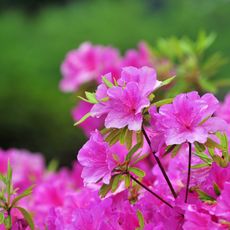Growing Avalon Plums: Tips On Caring For Avalon Plum Trees

Ah, the sweet juiciness of a plum. The delights of a perfectly ripe specimen can't be overstated. Avalon plum trees produce some of the best of this type of fruit. Avalons are known for their sweetness, lending them the name of dessert plum. It was bred as a competitor to the popular Victoria but with a sweeter flavor and better resistance. Learn about Avalon plum maintenance so you can enjoy these delicious fruits in your garden.
What is the Avalon Dessert Plum?
The new Avalon dessert plum is a large fruit that ripens about 10 days earlier than Victoria. Aficionados of these fruits should try growing Avalon plums, as they are sweetly juicy, quite large, and beautifully blushed. Best eaten fresh, they also make great preserves and canned fruit. Best of all, growing Avalon plums is fairly low maintenance and they are considered strong, versatile trees. Plums are stone fruits and are closely related to peaches, nectarines, and almonds. Avalon plum trees are relatively small varieties, generally attaining only 16 feet (5 m.) in height with a similar spread and an open, spreading habit. They are a U.K. introduction from 1989. Flowers are white and appear in spring. Trees have been known to bear within two years of planting and produce prolific amounts of the fruit. The large plums are attractively peachy-pink with freestone pits and creamy, blushed flesh. At this stage, they are best for cooking, but if left on the tree to turn purple-red, the flesh is softer and best eaten out of hand.
Growing Avalon Plums
These trees need average to fertile soil in a well-draining location. Full sun sites produce the most fruit. The tree is self-fruiting and needs no pollinating partner, but larger crops can be expected with Edwards or Victor plum trees nearby. One of the tree's biggest assets is its disease resistance, but it needs a slightly warmer climate than Victoria to produce. Fruits are ready in mid-August. The tree tends to over crop, so pruning annually is a crucial part of caring for Avalon plum. Without judicious removal of some of the developing fruit, plums may fail to ripen, stems can crack, and overall fruit quality suffers. Young trees should be trained to a sturdy, central leader with strong, scaffold branches. By the third year, pruning is directed to producing an open vase shape that allows air and sun to penetrate the canopy. This not only promotes fruit development but prevents fungal diseases. By the fourth year, only minimal pruning is required in spring to remove damaged wood and errant branches. Once fruits begin to appear, thin them to 1 inch (2.5 cm.) between each plum. Another important aspect to caring for Avalon plum is feeding. Using a slow release organic product, like bone meal, in spring. Cover around the root zone with mulch to preserve moisture and prevent competitive plants.
Gardening tips, videos, info and more delivered right to your inbox!
Sign up for the Gardening Know How newsletter today and receive a free copy of our e-book "How to Grow Delicious Tomatoes".

Bonnie Grant is a professional landscaper with a Certification in Urban Gardening. She has been gardening and writing for 15 years. A former professional chef, she has a passion for edible landscaping.
-
 Ideal Azalea Water Requirements – For Lush, Healthy Shrubs That Will Thrive For Years
Ideal Azalea Water Requirements – For Lush, Healthy Shrubs That Will Thrive For YearsWhat are an azalea's water requirements? Learn how to keep these beautiful spring-blooming shrubs happy and healthy in your yard or container garden.
By Amy Grant
-
 7 Vegetables To Plant In April: Start Indoors Or Outside For A Bumper Summer Harvest
7 Vegetables To Plant In April: Start Indoors Or Outside For A Bumper Summer HarvestAchieve your growing ambitions with these best vegetables to plant in April – including cold-hardy crops to sow direct and tender varieties to start indoors
By Mary Ellen Ellis